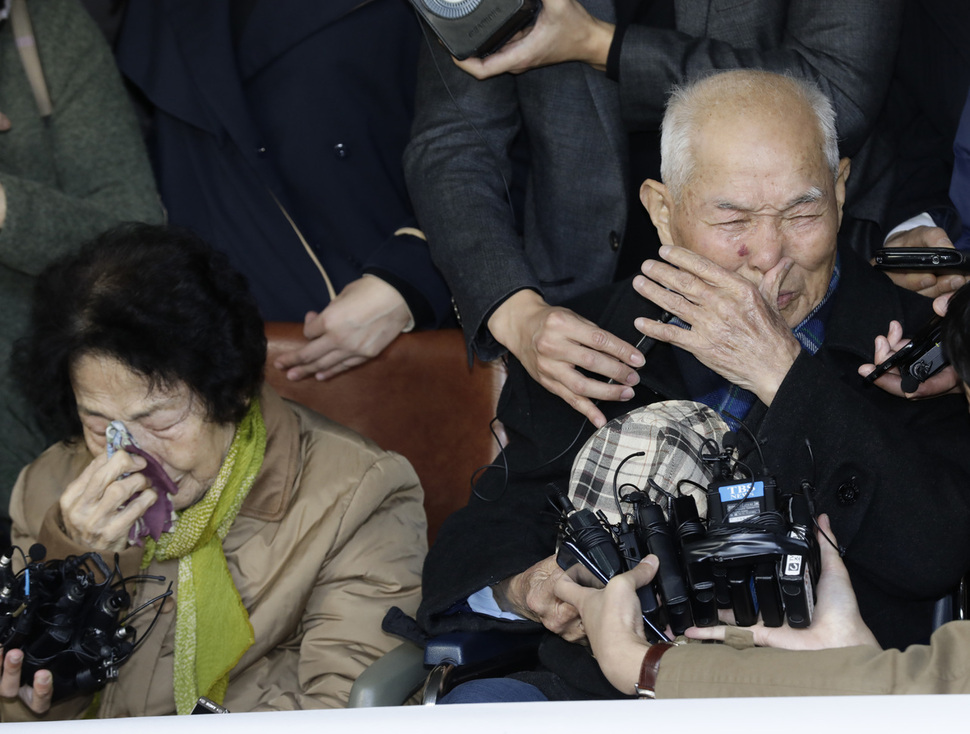Posted on : Oct.31,2018 16:47 KST
Modified on : Oct.31,2018 16:52 KST
 |
|
Lee Choon-sik, 94, is the last remaining survivor of a group of plaintiffs that filed suit against the Japanese company responsible for their forced mobilization and labor during the colonial occupation. Lee is seen shedding tears at the South Korean Supreme Court in Seoul on Oct. 30 after the court’s ruling that Nippon Steel & Sumitomo Metal Corporation should pay reparations to the victims. (Kim Myoung-jin, staff photographer)
|
The South Korean Supreme Court has produced a final ruling demanding that a Japanese company compensate victims of forced labor during the Japanese occupation. In an Oct. 30 full bench ruling presided over by Chief Justice Kim Myeong-soo, the court affirmed the original ruling in the second appeal on a case filed by Lee Choon-sik and other victims of forced labor demanding damages from Nippon Steel and Spumitomo Metal Corporation (formerly Japan Iron and Steel Co.), dismissing the Japanese company’s renewed appeal and ordering the payment of 100 million won (US$87,800) each to the plaintiffs.
The decision comes 13 years and 8 months after the victims first filed suit, and over five years after the case arrived from the second appeal stage. The other plaintiffs passed away in the meantime, leaving 94-year-old Lee as the only survivor. This decision is all too late in coming. It is also embarrassing to consider that the delay happened because of judicial “transactions,” where compensation for the victims’ forced labor was traded for overseas positions for judges. It wouldn’t be enough for the people involved in this judicial scandal to prostrate themselves before the souls of the departed plaintiffs.
The ruling is deeply significant in resolving the long delay caused in the case by the judicial scandal and belated awarding compensation for damages suffered during the Japanese occupation. Given the likelihood of a diplomatic row erupting with Tokyo over how to interpret the Korea-Japan Claims Settlement Agreement, Seoul will also need to respond appropriately.
In its en banc ruling yesterday, the Supreme Court determined that the plaintiffs’ right to claim damages was not included in the scope of that agreement, which was signed by the South Korean and Japanese governments in 1965. Its reasoning was that the right to claim compensation was the result of “inhumane and illegal acts on the part of a Japanese government, which were directly linked to the Japanese government’s illegal colonial rule and waging of a war of aggression.”
In other words, because there is no reference to the illegal nature of Japan’s colonial occupation anywhere in the Korea-Japan Claims Settlement Agreement or its annexes, and because the Japanese government outright repudiated any legal compensation for forced mobilization or laborers during the two sides’ negotiation process without acknowledging the illegality of its colonial rule, acts of victimization through illegal actions are not subject to the terms of the agreement.
The court also concluded that because South Korea received only US$300 million in grants rather than the full $1.22 billion it demanded in the negotiations, the amount could not be seen as including compensation for forced mobilization. This ruling makes complete sense in terms of the value system of the South Korean Constitution, which views Japan’s colonial government and forced mobilization of laborers as inherently illegal.
A prosecutors’ investigation has already uncovered how the Blue House under the Park Geun-hye administration sought to overturn the Supreme Court’s decision in 2012, citing the “ramifications” for its relationship with Japan, and how the Ministries of Foreign Affairs and Justice – and even the Supreme Court leadership – followed along in deferring a final judgment. Now that this case has become established as symbolic of judicial corruption, the full extent of judicial transactions orchestrated by former Chief Justice Yang Sung-tae and others will need to be fully brought to light to ensure that this ruling’s significance is not tarnished.
With procedures effectively under way now to pull out of the comfort women agreement reached by the South Korean and Japanese governments in 2015, there is a chance this ruling will lead to things souring for some time between Seoul and Tokyo. Indeed, Japanese Foreign Minister Taro Kono objected to the ruling as “utterly unacceptable” and “undermining the very legal foundation of friendly relations” between South Korea and Japan.
It’s a moment that calls for a judicious response from Seoul. Prime Minister Lee Nak-yon remained circumspect, announcing plans to “develop government response measures respectful of the court’s ruling” and voicing “hope that we can continue developing South Korea-Japan relations in a future-oriented direction.”
Some observers have focused on the possibility of an International Court of Justice complaint or other hardline response from Japan, noting the unavoidability of trial delays under Yang Sung-tae’s Supreme Court. But the case does not stand up without the consent of South Korea as one of the parties. In a democratic state subject to the separation of powers, it is common sense that independent decisions by courts are to be respected. As a democratic government itself, Japan should proceed with caution.
Please direct comments or questions to [english@hani.co.kr]









